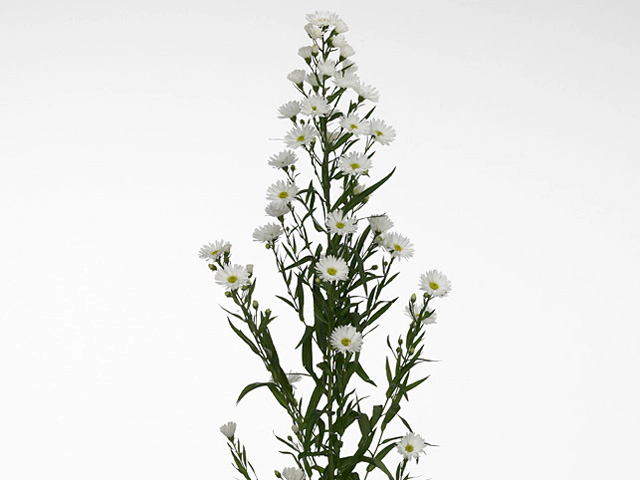Aster Linda

| Leaf tip | Pointed/acute |
| Flower type | Single |
| Leaf margin | Serrate |
| Flower scent | Weak; Unscented |
| Winter hardness | Excellent (USDA-zone 1,2,3,4) |
| Flower color | White-white-999D |
| Leaf, general shape | Linear |
| Leaf, scent | Unscented |
| Flower diameter | 2,5 - 3 cm |
| Inflorescence | Raceme; Capitulum (head) |
| Structure (tissues) | Herbaceous |
| Leaf duration | Deciduous |
| Leaf size | 10 - 15 cm |
| Light conditions | Sunny |
| Leaf division | Simple |
| Inflorescence length | 25 - 30 cm |
| Inflorescence diameter | 5 - 10 cm |
| Plant, growth type | Erect |
| Flower sex (distribution) | Monoecious (flowers bisexual) |
| Leaf, main color | Medium green; Dark green |
| Leaf colour, pattern | Unicolored; Unicolored |
| Flower color distribution | Unicolored |
| Toxicity (if consumed) | Not or barely |
| Moisture requirements | Well-drained; Moist |
The Aster Linda, also known as the Michaelmas Daisy, is a beautiful perennial flower that blooms in the late summer or early fall. With its single white flowers and pointed, serrated leaves, it adds a touch of elegance to any garden.
One of the key features of the Aster Linda is its excellent winter hardiness. It can withstand even the harshest climates, making it suitable for USDA zones 1 to 4. This means that it can thrive in cold, snowy winters and still come back strong in the spring.
The flowers of the Aster Linda may be small, with a diameter of 2.5 to 3 cm, but they make up for it with their abundance. The plant produces inflorescences in the form of racemes or capitulums (heads), which can reach a length of 25 to 30 cm and a diameter of 5 to 10 cm. This creates a stunning display of white blooms that can attract butterflies and bees to your garden.
The Aster Linda is a herbaceous plant, meaning that its stems are soft and green. The leaves are linear in shape, with a size of 10 to 15 cm. They have a medium to dark green color and a serrated margin, giving them an interesting texture. The leaves are also deciduous, meaning they will fall off the plant in the winter and regrow in the spring.
This plant thrives in sunny conditions and requires well-drained soil. It is important to provide adequate moisture for the Aster Linda, as it prefers a slightly moist environment. However, it can tolerate dry periods, making it a low-maintenance choice for gardeners.
The Aster Linda is a monoecious plant, meaning that it has both male and female flowers on the same plant. This ensures successful pollination and seed production. Despite its abundance of flowers, the Aster Linda has a weak or unscented fragrance, so it may not attract individuals looking for heavily scented blooms.
One of the benefits of the Aster Linda is that it is not toxic, making it a safe choice for households with pets or children. However, it is always important to practice caution and prevent consumption of any plant material.
In conclusion, the Aster Linda is a stunning addition to any garden. Its white flowers, pointed leaves, and excellent winter hardiness make it a popular choice among gardeners. With its low-maintenance requirements and ability to attract pollinators, it is a must-have for any flower enthusiast.
Market availability index by month:
| Jan. | Feb. | Mar. | Apr. | May | Jun. | Jul. | Aug. | Sep. | Oct. | Nov. | Dec. |
|---|---|---|---|---|---|---|---|---|---|---|---|
| 3 | 3 | 2 | 3 | 4 | 3 | 3 | 3 | 3 | 3 | 3 | 3 |